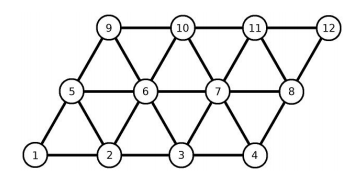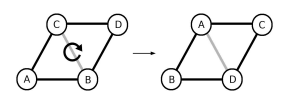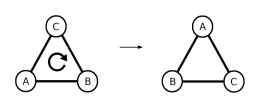COCI '18 Contest 4 #4 Slagalica
View as PDFSince he learnt how to solve the Rubik's cube, Jurica has also been interested in other puzzles of this
kind and he recently created an enigmatic toy himself. We can imagine Jurica's puzzle as a triangular
net in the form of a parallelogram whose nodes are arranged in rows and
columns. The rows are
labeled from
to
from the bottom up, and the columns are labeled
to
from left to right.
Each node is denoted by coordinates
, where
is the row and
is the column. Each node has a
unique integer value between
and
written in it, and the puzzle is considered solved when the
first row contains numbers from
to
ordered from left to right, the second row contains numbers
from
to
in the same order, etc. The picture below shows a solved puzzle of 3 rows and 4
columns.

The layout of the puzzle can be changed in two ways:
By selecting the unit sized rhombus whose nodes are determined by the coordinates
,
,
and
, and rotating the node values in the clockwise direction.

By selecting a unit sized equilateral triangle whose nodes are determined by the coordinates
,
and
, and rotating the node values in the clockwise direction.

On one boring day, Jurica scrambled the puzzle, writing down the moves he had made on a piece of
paper. This sequence of moves he called a mega-move, and explained the application of mega-move
as the sequential application of the moves written on the paper. After that, he has repeatedly made
the same mega-move several times. He noticed an unusual regularity soon. Starting from a solved
puzzle, after exactly mega-moves, the puzzle will again be solved (the first time since applying the
mega-moves).
For given integers ,
and
, determine if there is a mega-move that will allow Jurica to solve the
puzzle after exactly
repetition of that mega-move, and if so, print that sequence of moves. Note:
The solution is not necessarily unique and does not have to be optimal in the number of moves,
but the number of moves is limited (see section Input).
Input Specification
The first line contains three integers
and
, the numbers from the
task description.
Output Specification
If there is not such a mega-move that meets the conditions from the task, print -1 in the only line.
Otherwise, print the number of moves
in the first line and in the following
lines one move in the following form:
R x y(without the quotation marks) if it is a rotation of a rhombus (operation 1), orT x y(without the quotation marks) if it is a rotation of an equilateral triangle (operation 2), whereas the coordinaterepresents the bottom left node of the rhombus or the triangle and it holds that
and
.
Constraints
In the test samples worth 40% of the points it will hold that and
.
Sample Input 1
2 3 2Sample Output 1
5
R 1 1
R 1 1
T 1 1
T 1 1
T 1 1Sample Input 2
3 3 12Sample Output 2
3
R 1 1
T 2 2
T 2 1Sample Input 3
5 4 116Sample Output 3
-1
Comments